最新云计算中侧信道攻击的防御-毕业论文外文翻译整理
计算机网络安全论文之计算机网络攻击与防御技术
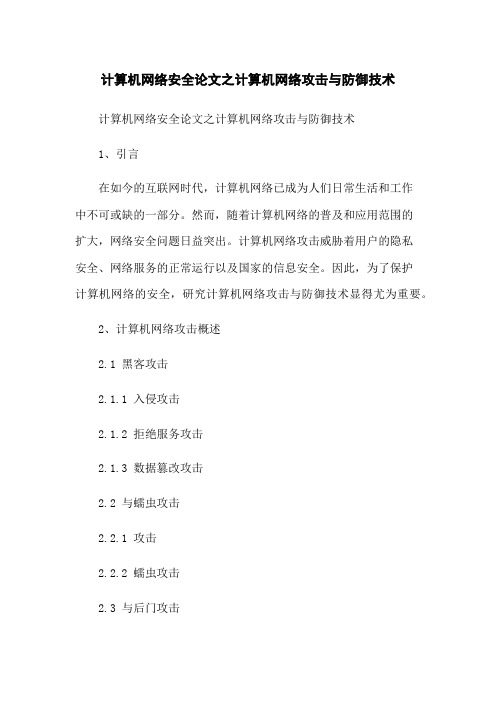
计算机网络安全论文之计算机网络攻击与防御技术计算机网络安全论文之计算机网络攻击与防御技术1、引言在如今的互联网时代,计算机网络已成为人们日常生活和工作中不可或缺的一部分。
然而,随着计算机网络的普及和应用范围的扩大,网络安全问题日益突出。
计算机网络攻击威胁着用户的隐私安全、网络服务的正常运行以及国家的信息安全。
因此,为了保护计算机网络的安全,研究计算机网络攻击与防御技术显得尤为重要。
2、计算机网络攻击概述2.1 黑客攻击2.1.1 入侵攻击2.1.2 拒绝服务攻击2.1.3 数据篡改攻击2.2 与蠕虫攻击2.2.1 攻击2.2.2 蠕虫攻击2.3 与后门攻击2.3.1 攻击2.3.2 后门攻击2.4 社会工程学攻击2.4.1 钓鱼攻击2.4.2 伪造身份攻击2.4.3 信息收集攻击3、计算机网络攻击技术分析3.1 网络扫描技术3.2 漏洞利用技术3.3 密码技术3.4 数据窃取技术3.5 中间人攻击技术3.6 无线网络攻击技术4、计算机网络安全防御技术4.1 访问控制技术4.2 网络防火墙技术4.3 数据加密技术4.4 入侵检测与防御技术4.5 安全策略与管理技术4.6 网络监测与日志管理技术5、法律名词及注释5.1 《计算机信息系统安全保护条例》5.2 《网络安全法》5.3 《刑法》中有关网络犯罪的相关条款6、结束语通过对计算机网络攻击与防御技术的研究,我们可以更好地理解网络攻击的原理和方法,并且运用相应的防御技术来保护计算机网络的安全。
只有不断加强网络安全防护,我们才能够更好地应对日益严峻的网络安全威胁。
附件:相关统计数据、实验结果等。
法律名词及注释:1、《计算机信息系统安全保护条例》:该条例是我国《中华人民共和国计算机信息系统安全保护条例》,对计算机信息系统的安全保护进行了规范和约束。
2、《网络安全法》:该法规定了我国对网络安全的管理和保护,旨在维护国家安全和社会稳定。
3、《刑法》中有关网络犯罪的相关条款:该条款规定了针对网络犯罪的法律责任和处罚。
硬件安全中的侧信道攻击与防御技术研究

硬件安全中的侧信道攻击与防御技术研究一、背景介绍随着计算机技术的不断进步,计算机硬件也在不断发展,各种新型计算机设备不断涌现,计算机硬件的管理与保护也成为了一项极其重要的任务。
而在计算机硬件安全领域,侧信道攻击已然成为了不可忽视的一种攻击方法。
侧信道攻击是指黑客通过对计算机硬件设备的不正常使用或设计缺陷的利用,从而获取计算机系统内部关键信息的一种攻击方式。
二、侧信道攻击原理侧信道攻击的攻击原理是基于计算机硬件设备的特殊性质,即在执行某些操作时,设备可能会产生非预期的信号。
这些信号可以被黑客所利用,潜在地泄露出计算机系统的机密信息。
这种攻击方式并不需要攻击者对被攻击的系统的完全控制,而是通过对系统中的信号进行捕获和分析,从而从中匿名地提取出关键信息,比如密码、密钥等。
在实际的侧信道攻击中,黑客常常会选择使用类似于功耗分析技术、电磁分析技术、时序分析技术等方法来展开攻击,从而获取目标系统的机密信息。
三、常见的侧信道攻击方式1、功耗分析功耗分析攻击的对象是计算系统中的功耗电流。
通过对功耗的分析,黑客可以了解到CPU中需要使用的指令、加密算法、秘钥等关键信息。
2、电磁分析电磁分析攻击是指通过捕获电磁波信号,从中获取敏感的系统内部信息。
黑客可以在距离目标设备一定的距离处放置接收器,对电磁辐射信号进行分析和处理,从而窃取计算机系统的机密信息。
3、时序分析时序分析攻击是指通过捕获执行时钟频率和时钟周期等信号,从中分析信息流。
黑客通过对时序信号的分析,可以揭示出计算机系统的内部运行机制以及实际的运行情况,从而窃取系统中的敏感信息。
四、常用的防御技术1、目标身份(Target Identity)技术此技术指的是对目标设备进行身份认证。
在传统的身份认证方式之外,通过采取静态功耗和动态功耗分析技术,对目标系统进行验证,对于身份未知的设备,及时识别并防御。
2、面向安全片(Secure chips)技术通过安装复杂和高级别的密码算法和其他安全协议,对硬件进行加密防护。
计算机英语论文网络攻击与防御报告
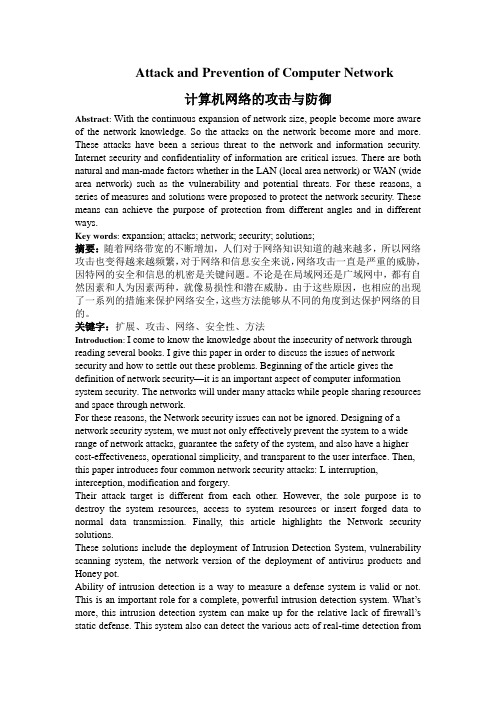
Attack and Prevention of Computer Network计算机网络的攻击与防御Abstract: With the continuous expansion of network size, people become more aware of the network knowledge. So the attacks on the network become more and more. These attacks have been a serious threat to the network and information security. Internet security and confidentiality of information are critical issues. There are both natural and man-made factors whether in the LAN (local area network) or WAN (wide area network) such as the vulnerability and potential threats. For these reasons, a series of measures and solutions were proposed to protect the network security. These means can achieve the purpose of protection from different angles and in different ways.Key words: expansion; attacks; network; security; solutions;摘要:随着网络带宽的不断增加,人们对于网络知识知道的越来越多,所以网络攻击也变得越来越频繁,对于网络和信息安全来说,网络攻击一直是严重的威胁,因特网的安全和信息的机密是关键问题。
安全多方计算技术对抗侧信道攻击

安全多方计算技术对抗侧信道攻击在当今数字化的时代,信息安全的重要性日益凸显。
随着数据的价值不断提升,保护数据的隐私和安全成为了至关重要的任务。
在众多的安全威胁中,侧信道攻击是一种难以防范但危害极大的攻击方式。
而安全多方计算技术的出现,为对抗侧信道攻击提供了有力的武器。
侧信道攻击是一种通过分析密码系统在运行时产生的旁路信息来获取敏感信息的攻击手段。
这些旁路信息可能包括计算时间、功耗、电磁辐射等。
攻击者通过对这些看似无关紧要的信息进行精密的分析和处理,有可能推断出加密密钥或其他机密信息。
例如,通过监测一个设备在执行加密操作时的功耗变化,攻击者可能能够推断出正在处理的数据的某些特征。
安全多方计算技术则是一种允许多个参与方在不泄露各自数据的前提下共同计算某个函数的结果的技术。
它基于密码学原理,确保了在计算过程中各方的隐私得到保护。
在安全多方计算中,各方的数据始终以加密的形式存在,并且计算过程也是在加密状态下进行的。
那么,安全多方计算技术是如何对抗侧信道攻击的呢?首先,安全多方计算技术从根本上减少了敏感信息的暴露。
在传统的计算模式中,数据往往需要在明文状态下进行处理,这就给了侧信道攻击者可乘之机。
而在安全多方计算中,数据从一开始就是加密的,即使在计算过程中,攻击者也无法获取到有价值的明文信息。
这就大大降低了侧信道攻击成功的可能性。
其次,安全多方计算技术采用了特殊的加密算法和协议,使得计算过程中的中间结果也得到了保护。
这些加密算法和协议通常具有抗侧信道攻击的特性,能够有效地防止攻击者通过分析中间结果来获取敏感信息。
此外,安全多方计算技术还通过混淆和随机化等手段来增加侧信道信息的不确定性。
例如,在计算过程中引入随机噪声,使得攻击者难以从侧信道信息中提取出有规律的模式。
为了更好地理解安全多方计算技术对抗侧信道攻击的效果,我们可以通过一个具体的例子来说明。
假设有两个企业 A 和 B,它们想要合作分析双方的销售数据以找出共同的市场趋势,但又不想泄露各自的具体销售数据。
网络安全侧信道攻击与防御研究

网络安全侧信道攻击与防御研究随着互联网的普及,网络安全问题已经成为了许多企业和个人必须面对的重要问题。
如今,网络安全已经不仅仅是系统漏洞、病毒攻击和网络钓鱼,还包括了侧信道攻击。
侧信道攻击是一种隐蔽而有效的攻击方式,它并不是通过直接攻击系统软硬件漏洞来实现的,而是通过获取系统运行时的一些信息,推测密钥的一些标准值等,从而对系统进行攻击。
本文将探讨侧信道攻击的原理、类型以及防御策略。
侧信道攻击的原理传统的密码体制的安全性是建立在关于密码本身的攻击模型之上的,而侧信道攻击则是一种基于计时、功耗、电磁泄漏、声音等物理特性的攻击方式。
侧信道攻击是一种利用被攻击者生成密文时,与密文和明文无关的物理特征进行攻击的方式。
攻击者通过侧信道来推测加密算法的状态信息,从中获取有关密码的信息。
其实现的基本原理是对加密系统启发式攻击,通过分析密文对明文的间接影响,探测加密算法的特点。
侧信道攻击的类型1. 计时攻击计时攻击是一种基于加解密算法运行时间的攻击方式,攻击者将探测时间和标准时间进行比较,借此推算出密码学密钥值的一些信息。
2. 电磁泄漏攻击电磁泄漏攻击基于计算机设备的电磁波,听其和扫描电镜等高敏感识别技术来侦测计算机装置发射出的电磁辐射,进而搜集电磁泄漏数据,然后进行数据处理进行信息解密。
3. 缓存攻击缓存攻击是一种基于计算机缓存的攻击,攻击者分析缓存中的信息,利用时间差分析,推算密钥的信息。
防御侧信道攻击的策略1. 引入随机措施为了防止侧信道攻击,随机化是一个重要的措施。
随机化应用在加解密草案的其他部分,例如密钥扩展和访问模式选择上。
对攻击者难以预料的随机性会使得攻击者的攻击变得更难,减小攻击者的成功率。
2. 区分式访问控制区分式访问控制也是另一种防御侧信道攻击的有效方法。
其方法是根据对不同安全等级的数据采用不同的访问方式。
例如,在使用Smarts卡键入PIN时,多的一次执行会提供不同的资源访问控制,这有助于减少侧信道攻击的成功率。
硬件侧信道攻击与防御研究

硬件侧信道攻击与防御研究近年来,随着计算机硬件的发展,硬件侧信道攻击成为信息安全领域中备受关注的一个重要问题。
硬件侧信道攻击利用硬件设备本身的一些信息泄露通道,通过分析这些泄露的信息,来获取目标系统内部的关键信息,这对于保护个人隐私、商业机密以及国家安全都带来了巨大的威胁。
在硬件侧信道攻击中,最常见的攻击方式包括时序攻击、电磁攻击、功耗攻击和故障攻击等。
其中,时序攻击是一种通过监视目标设备的执行时间和内部状态来推导出目标的密钥或其他敏感信息的攻击方式。
电磁攻击则是通过测量目标设备产生的电磁辐射来获得目标的信息,例如从噪声中分析加密数据。
功耗攻击是通过监视目标设备的功耗来推断出目标的密钥。
而故障攻击则是利用目标设备在受到干扰或攻击时产生的异常行为来推导出目标的信息。
面对这些硬件侧信道攻击,研究人员和安全专家们提出了一系列的防御措施。
其中一种常用的方法就是对硬件进行物理层面的防护。
例如,在芯片设计和制造过程中,可以采用随机性增加技术,如随机化电路的电气参数、引入噪声和干扰等,从而降低攻击者分析信号的准确性。
此外,还可以对芯片进行屏蔽和隔离,以减小电磁辐射和电磁泄漏。
此外,对于一些关键设备如智能卡、密码机等,可以采用物理封装技术来防御侧信道攻击。
另一种常见的防御措施是采用密码学方法。
通过使用强大的加密算法和密钥管理协议,可以提供对侧信道攻击的有效防护。
例如,可以使用掩码技术来隐藏电路的功耗泄漏。
还可以使用掩码技术以及纠错码等技术,来对硬件设备传送的信息进行编码和解码,从而编码后的信息不再包含敏感信息。
此外,软件也可以在一定程度上提供对硬件侧信道攻击的防护。
在程序编写过程中,可以使用抗侧信道攻击技术,通过合理的算法和代码设计,减小信号泄露的可能性。
同时,也可以提高软件的安全性和完整性,以阻止攻击者进行故意的信号干扰和注入攻击。
更进一步的研究方向包括制定更先进的防御方案,例如更强大的随机化技术、更安全的物理封装和物理屏蔽方案等。
毕业论文英文文献翻译--计算机网络安全浅析(5篇)

毕业论文英文文献翻译--计算机网络安全浅析(5篇)第一篇:毕业论文英文文献翻译--计算机网络安全浅析计算机网络安全浅析摘要:针对计算机网络系统存在的安全性和可靠性问题,本文从网络安全的重要性、理论基础、具备功能以及解决措施等方面提出一些见解,并且进行了详细阐述,以使广大用户在计算机网络方面增强安全防范意识。
关键词:计算机网络虚拟专用网技术加密技术防火墙引言:随着计算机网络技术的发展,网络的安全性和可靠性已成为不同使用层次的用户共同关心的问题。
人们都希望自己的网络系统能够更加可靠地运行,不受外来入侵者干扰和破坏。
所以解决好网络的安全性和可靠性问题,是保证网络正常运行的前提和保障。
一、网络安全的重要性。
在信息化飞速发展的今天,计算机网络得到了广泛应用,但随着网络之间的信息传输量的急剧增长,一些机构和部门在得益于网络加快业务运作的同时,其上网的数据也遭到了不同程度的攻击和破坏。
攻击者可以窃听网络上的信息,窃取用户的口令、数据库的信息;还可以篡改数据库内容,伪造用户身份,否认自己的签名。
更有甚者,攻击者可以删除数据库内容,摧毁网络节点,释放计算机病毒等等。
这致使数据的安全性和自身的利益受到了严重的威胁。
根据美国FBI (美国联邦调查局)的调查,美国每年因为网络安全造成的经济损失超过170 亿美元。
75的公司报告财政损失是由于计算机系统的安全问题造成的。
超过50的安全威胁来自内部。
而仅有59的损失可以定量估算。
在中国,针对银行、证券等金融领域的计算机系统的安全问题所造成的经济损失金额已高达数亿元,针对其他行业的网络安全威胁也时有发生。
由此可见,无论是有意的攻击,还是无意的误操作,都将会给系统带来不可估量的损失。
所以,计算机网络必须有足够强的安全措施。
无论是在局域网还是在广域网中,网络的安全措施应是能全方位地针对各种不同的威胁和脆弱性,这样才能确保网络信息的保密性、完整性和可用性。
二、网络安全的理论基础。
国际标准化组织(ISO)曾建议计算机安全的定义为:“计算机系统要保护其硬件、数据不被偶然或故意地泄露、更改和破坏。
计算机英语论文网络攻击与防御

计算机英语论文网络攻击与防御第一篇:计算机英语论文网络攻击与防御计算机网络攻击和防范摘要:网络信息的安全和保密是一个至关重要的问题。
无论是在局域网还是在广域网中,都存在着自然和人为等诸多因素的脆弱性和潜在威胁。
关键词:计算机;网络;安全;防范引言:本文旨在介绍现在的网络安全问题,网络攻击的方式,步骤,防范。
防火墙的结构,类型,和具体应用。
使大家对于一般的网络攻击有所防范,可以用防火墙进行查杀和防护病毒。
正文:网络安全,是计算机信息系统安全的一个重要方面。
如同打开了的潘多拉魔盒,计算机系统的互联,在大大扩展信息资源的共享空间的同时,也将其本身暴露在更多恶意攻击之下。
如何保证网络信息存储、处理的安全和信息传输的安全的问题,就是我们所谓的计算机网络安全。
信息安全是指防止信息财产被故意的或偶然的非法授权泄露、更改、破坏或使信息被非法系统辩识、控制;确保信息的保密性、完整性、可用性、可控性。
信息安全包括操作系统安全、数据库安全、网络安全、病毒防护、访问控制、加密和鉴别七个方面。
设计一个安全网络系统,必须做到既能有效地防止对网络系统的各种各样的攻击,保证系统的安全,同时又要有较高的成本效益,操作的简易性,以及对用户的透明性和界面的友好性。
网络安全攻击,主要有四种方式L中断、截获、修改和伪造。
中断是以可用性作为攻击目标,它毁坏系统资源,使网络不可用。
截获是以保密性作为攻击目标,非授权用户通过某种手段获得对系统资源的访问。
修改是以完整性作为攻击目标,非授权用户不仅获得访问而且对数据进行修改。
伪造是以完整性作为攻击目标,非授权用户将伪造的数据插入到正常传输的数据中。
网络安全的解决方案一、入侵检测系统部署入侵检测能力是衡量一个防御体系是否完整有效的重要因素,强大完整的入侵检测体系可以弥补防火墙相对静态防御的不足。
对来自外部网和校园网内部的各种行为进行实时检测,及时发现各种可能的攻击企图,并采取相应的措施。
具体来讲,就是将入侵检测引擎接入中心交换机上。
如何防范网络攻击作文

如何防范网络攻击作文英文回答:How to Defend Against Cyber Attacks.Cyber attacks have become increasingly prevalent in today's digital age. It is crucial for individuals and organizations to take proactive measures to protect themselves against these threats. In this essay, I will discuss some effective strategies to defend against cyber attacks.First and foremost, it is essential to keep all software and devices up to date. Regularly updating operating systems, antivirus software, and applications can help prevent cyber attacks. These updates often include security patches that address vulnerabilities and strengthen the system's defenses. For example, I always make sure to install the latest updates on my computer and smartphone to stay protected against potential threats.Another important aspect of defending against cyber attacks is creating strong and unique passwords. Many people make the mistake of using simple and easily guessable passwords, such as "123456" or "password." It is crucial to use a combination of uppercase and lowercase letters, numbers, and special characters to create strong passwords. Additionally, using different passwords for different accounts adds an extra layer of security. For instance, I use a password manager to generate and store complex passwords for all my online accounts.Furthermore, being cautious while browsing the internet and opening emails is vital. Cybercriminals often use phishing emails and malicious websites to trick users into revealing sensitive information or installing malware. Itis essential to verify the authenticity of emails and websites before clicking on any links or providing personal information. For instance, I always double-check the sender's email address and look for any suspicious signs before opening an email or clicking on a link.Additionally, backing up data regularly is an effective defense against cyber attacks. Ransomware attacks, where hackers encrypt files and demand a ransom for their release, have become increasingly common. By regularly backing up important files and data to an external hard drive or cloud storage, individuals and organizations can restore their information without paying the ransom. For example, I use a cloud storage service to automatically backup my filesevery week, ensuring that I always have a recent copy of my data.Lastly, educating oneself about cybersecurity best practices is crucial in defending against cyber attacks. Staying updated on the latest threats, learning about common attack techniques, and understanding how torecognize and respond to potential threats cansignificantly reduce the risk of falling victim to cyber attacks. For instance, I regularly read cybersecurity blogs and follow industry experts on social media to stayinformed about the latest trends and best practices.中文回答:如何防范网络攻击。
介绍防御措施英文作文

介绍防御措施英文作文英文:As we all know, cybersecurity is becoming increasingly important in today's digital age. With the rise of cyber attacks and data breaches, it's important to take necessary measures to protect ourselves and our sensitive information. Here are some defense measures that I use to safeguard my online presence:1. Strong Passwords: I always use strong and unique passwords for all my online accounts. I avoid using common words or phrases, and I always include a mix of uppercase and lowercase letters, numbers, and symbols.2. Two-Factor Authentication: I enable two-factor authentication whenever possible. This adds an extra layerof security by requiring a code or fingerprint in additionto a password to access my accounts.3. Regular Updates: I make sure to keep all my software and devices up to date with the latest security patches and updates. This helps to close any vulnerabilities that hackers may exploit.4. Antivirus Software: I use reputable antivirus software to protect my devices from malware and viruses. This software can detect and remove any malicious software that may be present on my device.5. Phishing Awareness: I always stay vigilant against phishing scams. I never click on suspicious links or download attachments from unknown sources. I also verify the authenticity of emails and messages before responding.By implementing these defense measures, I am able to better protect myself against cyber threats and keep my sensitive information safe.中文:众所周知,在今天的数字时代,网络安全越来越重要。
数据加密技术中的侧信道防御策略

数据加密技术中的侧信道防御策略在今天的信息时代,数据加密技术被广泛运用于各个领域,以保证数据的安全性和保密性。
然而,随着科技的不断发展,恶意攻击者也在不断寻找突破加密算法的方法。
其中,侧信道攻击成为了一种常见的攻击手段。
本文将围绕数据加密技术中的侧信道问题展开,介绍侧信道攻击的原理和常见的防御策略,以期为加强数据加密的安全性提供参考。
一、侧信道攻击原理侧信道攻击是一种通过分析加密设备在加密过程中产生的非直接信息泄露来突破加密算法的攻击手段。
攻击者可以通过观察加密设备在处理不同输入数据时的功耗、电磁辐射、时钟频率等侧信道信息来推测密钥或者明文信息。
这种攻击方式不直接针对算法本身,而是利用了算法在物理实现过程中产生的泄露信息。
二、常见侧信道攻击1.时钟频率分析攻击时钟频率分析攻击是一种基于硬件实现的侧信道攻击方式。
攻击者可以通过测量加密设备在不同操作状态下的时钟频率来分析不同操作状态下的功耗变化,从而推测出设备运行的算法和密钥信息。
2.功耗分析攻击功耗分析攻击是一种基于能耗的侧信道攻击方式。
攻击者通过测量加密设备在不同操作状态下的功耗变化来推断设备处理不同输入数据时的运算复杂度和数据敏感性,从而获得密钥信息。
3.电磁辐射攻击电磁辐射攻击是一种利用加密设备在运行时产生的电磁波信号进行信息窃取的侧信道攻击方式。
攻击者可以通过对设备附近电磁波信号的监听和分析,推断出设备的操作状态、运算过程以及可能的密钥信息。
三、侧信道防御策略为了有效应对侧信道攻击,提高数据加密的安全性,以下是几种常见的侧信道防御策略:1.高级对抗分析技术高级对抗分析技术是一种通过改变加密算法的执行路径、混淆加密算法的执行时间和功耗等侧信道信息以抵抗攻击者的分析能力。
例如,通过在算法执行路径上增加随机操作,使得攻击者无法通过观察设备的功耗等特征来推断密钥信息。
2.噪声添加技术噪声添加技术是一种向加密设备中注入噪声以干扰攻击者的侧信道分析的方法。
如何防范网络攻击为主题的作文
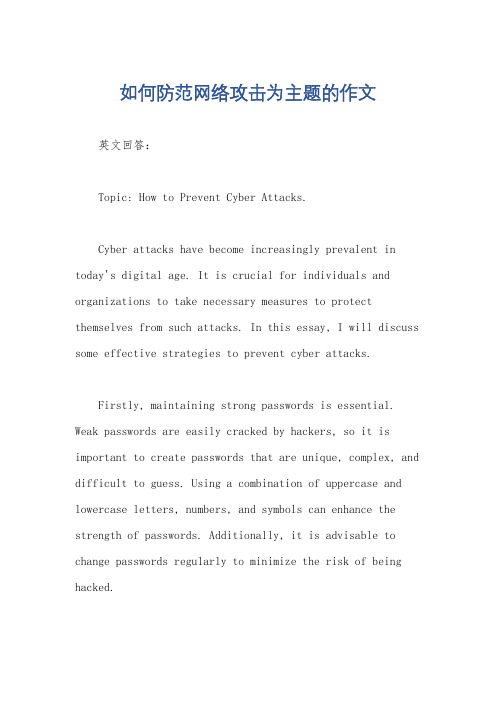
如何防范网络攻击为主题的作文英文回答:Topic: How to Prevent Cyber Attacks.Cyber attacks have become increasingly prevalent in today's digital age. It is crucial for individuals and organizations to take necessary measures to protect themselves from such attacks. In this essay, I will discuss some effective strategies to prevent cyber attacks.Firstly, maintaining strong passwords is essential. Weak passwords are easily cracked by hackers, so it is important to create passwords that are unique, complex, and difficult to guess. Using a combination of uppercase and lowercase letters, numbers, and symbols can enhance the strength of passwords. Additionally, it is advisable to change passwords regularly to minimize the risk of being hacked.Secondly, keeping software and operating systems up to date is crucial in preventing cyber attacks. Developers release updates and patches to fix vulnerabilities and security loopholes in their software. By regularly updating our devices, we can ensure that we have the latest security measures in place to protect against potential attacks.Thirdly, being cautious while browsing the internet is vital. Many cyber attacks occur through phishing emails or malicious websites. It is important to be wary of suspicious emails or messages from unknown sources, as they may contain malicious links or attachments. Additionally, it is advisable to only visit reputable websites and avoid clicking on suspicious ads or pop-ups.Furthermore, using antivirus software and firewalls can provide an additional layer of protection against cyber attacks. Antivirus software can detect and remove malware, while firewalls can block unauthorized access to our devices or networks. It is essential to regularly update and scan our devices with antivirus software to ensure maximum protection.Lastly, educating ourselves and raising awareness about cyber security is crucial. By understanding common cyber attack methods such as phishing, malware, and ransomware, we can better identify and prevent potential threats. It is important to stay updated on the latest trends and best practices in cyber security to effectively safeguard ourselves and our digital assets.In conclusion, preventing cyber attacks requires a combination of proactive measures and awareness. By maintaining strong passwords, keeping software up to date, being cautious while browsing the internet, using antivirus software and firewalls, and staying informed about cyber security, we can significantly reduce the risk of falling victim to cyber attacks.中文回答:主题,如何防范网络攻击。
如何防范网络攻击作文
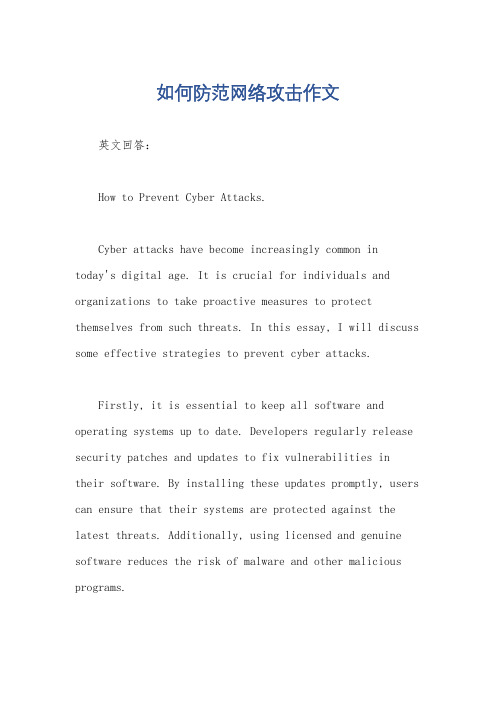
如何防范网络攻击作文英文回答:How to Prevent Cyber Attacks.Cyber attacks have become increasingly common intoday's digital age. It is crucial for individuals and organizations to take proactive measures to protect themselves from such threats. In this essay, I will discuss some effective strategies to prevent cyber attacks.Firstly, it is essential to keep all software and operating systems up to date. Developers regularly release security patches and updates to fix vulnerabilities intheir software. By installing these updates promptly, users can ensure that their systems are protected against the latest threats. Additionally, using licensed and genuine software reduces the risk of malware and other malicious programs.Secondly, strong and unique passwords are vital for safeguarding online accounts. Many people make the mistake of using easy-to-guess passwords or reusing the same password for multiple accounts. This makes it easier for hackers to gain unauthorized access. It is recommended to use a combination of uppercase and lowercase letters, numbers, and special characters in passwords. Furthermore, enabling two-factor authentication adds an extra layer of security by requiring users to provide a secondverification code or fingerprint scan.Another important measure is to be cautious while clicking on links or downloading attachments. Phishing emails and malicious websites often trick users into revealing sensitive information or installing malware. It is advisable to verify the authenticity of emails and websites before sharing personal or financial details. Additionally, using reliable antivirus software can help detect and remove potential threats.Regularly backing up important data is also crucial in preventing cyber attacks. Ransomware attacks, where hackersencrypt data and demand a ransom for its release, can be devastating. By regularly backing up data to an external hard drive or cloud storage, individuals and organizations can minimize the impact of such attacks. It is important to ensure that backups are stored securely and are not accessible to unauthorized individuals.Lastly, cybersecurity awareness and training play a significant role in preventing cyber attacks. Individuals should stay informed about the latest threats and best practices for online security. Organizations should conduct regular training sessions to educate employees about the importance of following security protocols and identifying potential risks.In conclusion, preventing cyber attacks requires a combination of technical measures and user awareness. By keeping software up to date, using strong passwords, being cautious while browsing, regularly backing up data, and promoting cybersecurity awareness, individuals and organizations can significantly reduce the risk of falling victim to cyber attacks.中文回答:如何防范网络攻击。
边信道攻击及防御的研究与实现

边信道攻击及防御的研究与实现边信道攻击及防御的研究与实现随着现代通信技术的不断发展与普及,信息安全问题日益凸显。
边信道攻击作为一种高度隐蔽的攻击手段,引起了各界的关注。
本文将从边信道攻击的基本原理、常见攻击手段,以及防御边信道攻击的技术措施等方面展开阐述。
边信道攻击是利用系统的边缘信息泄露来获取目标信息的一种攻击手段。
其原理是通过分析目标系统在工作过程中产生的边缘效应,如电磁辐射、功耗、时延、硬件状态等,推断出目标信息。
边信道攻击常见于密码学领域,因为密码算法的设计并未充分考虑边缘效应对系统的影响,导致系统的边道信息存在泄露的可能。
边信道攻击可以绕过传统的加密机制,直接威胁到系统的安全性。
在边信道攻击中,最为常见的攻击手段是通过分析目标设备的功耗来推断密钥信息。
功耗分析攻击是一种非常有效的攻击手段,它通过测量目标设备在不同密钥输入下的功耗变化,利用功耗和密钥之间的关系,从而恢复出目标密钥。
此外,时延分析攻击、电磁辐射分析攻击等也是边信道攻击的常见手段。
针对边信道攻击的威胁,研究人员提出了一系列防御技术。
一种常见的防御手段是噪声注入技术。
该技术通过在目标设备的功耗信号或其他边道信号中注入随机噪声,干扰攻击者的分析过程,从而掩盖目标信息。
此外,还可以采取特定的硬件设计,如功耗均衡、抗辐射设计等,以增强系统的安全性。
对于密码学领域来说,设计更加抵抗边信道攻击的算法也是防御的有效手段。
除了技术手段上的防御,用户和开发者在实际应用中也应加强对边信道攻击的意识和安全教育。
用户应定期更新设备的固件和软件,以及注意使用安全可靠的系统和应用程序。
开发者则应在设计和开发过程中注重系统的安全性,采用可信任的硬件和软件开发工具,避免出现安全漏洞和边道信号泄露的问题。
在未来,随着物联网、云计算等技术的快速发展,边信道攻击的防御将面临新的挑战和机遇。
更加复杂的系统架构和边道信号将给防御带来更大的困难,而新的技术手段和安全策略也将不断涌现。
云计算环境下的信息安全问题与防护策略探讨

1引言云计算的出现满足了广大用户对计算机硬件和软件的需求,对信息网络的发展也起到了巨大的促进作用。
但是随着云计算的广泛应用,越来越多的安全问题逐渐暴露出来,云计算环境下的信息技术不仅是具有发展力的科学技术,也是推动社会发展的重要力量。
近年来,随着互联网时代的不断发展,再加上各种网络技术的成熟和应用,云计算渐渐成为很重要的网络服务模式,尽管它带来了很多便利,但是在使用过程中也受到了严重的威胁,逐渐暴露的信息安全问题也急需解决。
2云计算与信息安全的概念云计算就是利用各种虚假化的网络资源然后组成一个庞大的资源池来统一地提供服务,由于云计算的安全性高且对设备的要求低,还能节省成本,所以被社会各领域所应用。
信息安全其实就是计算机网络安全,是利用网络安全技术来保障计算机各个系统的数据资源在网络环境下的安全性和有效性,防止在任何突发情况下遭到破坏和更改,造成网络服务中断。
信息化技术是目前互联网行业的重要技术,存在于社会的各个行业中,只有保障其管理系统不断地更新改进并完善入侵防御机制,才能更高效地提供安全的信息。
由于信息化依靠大量的数据来作为支持才得以保证数据的实时性和有效性,而云计算又是通过收集大量的资源数据来提供服务的,所以在云计算和信息化相结合的情况下能更好地提升信息化行业的发展水平。
3云计算环境下的信息安全问题3.1数据存储与传输安全问题数据存储安全与否直接影响着计算机网络的安全和发展,通过分析得知,传统的网络环境已经可以将数据运用广域网来实现共享,但是数据基本上还是以单机存储的方式来进行,这样存储安全就会受到限制。
在云计算网络环境下,数据的存储方式和传输过程都会在云端通过网络处理完成,用户端只发送数据请求,但是由于云计算很依赖开放的网络和开放的云端,因此,这也带来了一定的不安全性,使终端用户的机密性、安全性得不到保证。
对于在云计算环境下,用户存储在云端的数据怎么能够得到可靠的保护,而不会被泄密,不会存在身份认证等问题,在云计算的应用遍布天下的当下,这些问题都将被一一解决。
云计算环境下的网络攻击检测与防护研究

云计算环境下的网络攻击检测与防护研究近年来,随着云计算技术的不断发展和广泛应用,网络攻击已经成为了现代社会最为常见的安全威胁之一。
因此,在云计算环境下进行网络攻击检测与防护研究变得至关重要。
本文将探讨一些关键技术,以便更好地理解云计算环境下的网络攻击检测与防护。
1. 云计算环境下的网络攻击类型在云计算环境下,虚拟化技术被广泛应用,攻击者可以利用各种漏洞进行网络攻击。
这些攻击主要包括:虚拟化漏洞攻击、操作系统漏洞攻击、网络协议漏洞攻击、Web应用安全漏洞攻击等。
其中,Web 应用安全问题是云计算环境下的重要安全问题之一。
攻击者可以利用各种方式绕过Web应用程序的安全约束,例如:SQL注入、跨站点脚本攻击 (XSS)、跨站点请求伪造攻击 (CSRF)、文件包含攻击等。
2. 云计算环境下的网络攻击检测对于云计算环境下的网络攻击检测,传统的检测方法通常无法达到良好的效果。
因此,研究人员提出了一些新的网络攻击检测技术,以更好地解决云计算环境下的网络安全问题。
这些检测技术主要包括:基于行为的检测方法、基于机器学习的检测方法、基于深度学习的检测方法等。
在基于行为的检测方法中,研究人员通常使用网络流量分析技术来检测网络攻击。
这种方法利用网络流量特征来识别恶意流量,例如特殊的标志、网络协议类型、数据包大小等。
然而,基于行为的方法也存在一些问题,例如误报、漏报等,这些问题需要进一步的研究和优化。
在基于机器学习的检测方法中,研究人员通常使用大量的数据、特征提取和分类算法来训练模型,以便更好地识别网络攻击。
这些算法包括K近邻算法 (KNN)、基于决策树的算法、支持向量机 (SVM) 算法、随机森林算法等。
相比于基于行为的方法,基于机器学习的方法可以更准确地检测网络攻击,但是其需要更多的计算资源,以及更好的数据和特征。
在基于深度学习的检测方法中,研究人员可以使用卷积神经网络(CNN)、循环神经网络 (RNN)、长短时记忆网络 (LSTM) 等深度学习算法进行网络攻击检测。
云计算环境下的网络攻击与防御研究
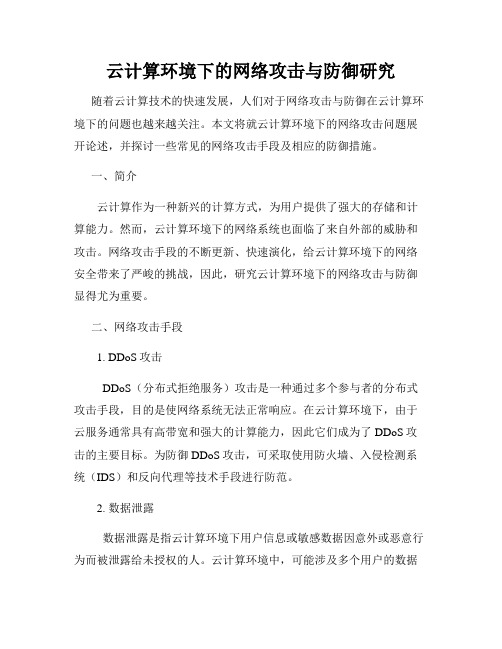
云计算环境下的网络攻击与防御研究随着云计算技术的快速发展,人们对于网络攻击与防御在云计算环境下的问题也越来越关注。
本文将就云计算环境下的网络攻击问题展开论述,并探讨一些常见的网络攻击手段及相应的防御措施。
一、简介云计算作为一种新兴的计算方式,为用户提供了强大的存储和计算能力。
然而,云计算环境下的网络系统也面临了来自外部的威胁和攻击。
网络攻击手段的不断更新、快速演化,给云计算环境下的网络安全带来了严峻的挑战,因此,研究云计算环境下的网络攻击与防御显得尤为重要。
二、网络攻击手段1. DDoS攻击DDoS(分布式拒绝服务)攻击是一种通过多个参与者的分布式攻击手段,目的是使网络系统无法正常响应。
在云计算环境下,由于云服务通常具有高带宽和强大的计算能力,因此它们成为了DDoS攻击的主要目标。
为防御DDoS攻击,可采取使用防火墙、入侵检测系统(IDS)和反向代理等技术手段进行防范。
2. 数据泄露数据泄露是指云计算环境下用户信息或敏感数据因意外或恶意行为而被泄露给未授权的人。
云计算环境中,可能涉及多个用户的数据存储在同一台物理服务器上,一旦攻击者入侵其中一个用户账户,就有可能获取到其他用户的隐私数据。
为防止数据泄露,建议加强身份验证与访问控制、加密存储与传输以及定期安全审计。
3. 恶意软件攻击恶意软件攻击是指通过恶意软件感染云计算环境下的主机或网络系统,破坏或窃取用户数据的行为。
恶意软件可能通过欺骗用户下载安装以及利用系统漏洞等方式进行传播。
为防止恶意软件攻击,用户应保持软件及系统的更新,并使用安全有效的反恶意软件工具。
三、网络防御措施1. 安全认证与访问控制在云计算环境中,为保护用户数据安全,需要采取严格的安全认证和访问控制措施。
确保只有经过身份验证的合法用户可以访问云服务,可采用双因素认证、访问令牌和访问权限控制等方式。
2. 数据加密与隔离为保护云计算环境下的数据安全,数据加密和隔离是非常重要的。
用户可以采用端到端加密技术,确保数据在传输和存储过程中得到有效的保护。
云计算的网络攻击与防御

云计算的网络攻击与防御云计算(Cloud Computing)作为一种新兴的信息科技,已经广泛应用于各个领域。
然而,随着云计算的快速发展,网络攻击也日益猖獗。
本文将就云计算的网络攻击与防御策略进行探讨。
一、云计算的网络攻击类型云计算环境中可能面临的网络攻击类型多种多样。
在云计算的三个主要服务模式中,即基础设施即服务(IaaS)、平台即服务(PaaS)和软件即服务(SaaS)中,都存在着不同形式的网络攻击。
1. 数据泄露:云计算使用共享资源的特性,使得云上的数据易于被攻击者获取。
攻击者可能通过网络监听、社会工程学等手段窃取云服务器上的敏感数据,进而造成重大损失。
2. 拒绝服务攻击(DDoS):DDoS攻击常见于云计算平台,攻击者通过大量虚假请求占用云计算环境的计算、存储资源,使得合法用户无法正常使用服务。
3. 虚拟机逃逸:虚拟机逃逸是指攻击者通过利用虚拟化层的漏洞,获取云服务器主机的控制权。
一旦攻击者获得控制权,就能够访问其他虚拟机,造成更大的安全风险。
二、云计算的网络防御策略要保护云计算环境,提高网络安全性,必须采取一系列的防御策略。
以下是常见的云计算网络攻击防御策略:1. 强化身份认证与访问控制:通过为云计算平台引入多层次的身份认证机制,如单一登录(Single Sign-On,SSO)、多因素认证等,可以有效防止非法用户进入云计算环境。
同时,建立细粒度的访问控制策略,限制用户对云资源的访问权限,也是重要的安全手段之一。
2. 加密与隔离技术:对云上的数据进行加密处理,可有效保护其安全性。
同时,采用虚拟局域网(VLAN)等隔离技术,将不同用户的虚拟机隔离开来,降低攻击者获取其他虚拟机控制权的可能性。
3. 检测与响应机制:建立完善的网络流量检测与日志监控系统,能够及时发现潜在的攻击行为。
一旦检测到异常活动,可以及时采取相应的响应措施,如封锁攻击源IP地址、切断受攻击系统与云环境的连接等。
4. 定期备份与灾难恢复:定期备份云计算环境中的重要数据,并建立完备的灾难恢复系统。
- 1、下载文档前请自行甄别文档内容的完整性,平台不提供额外的编辑、内容补充、找答案等附加服务。
- 2、"仅部分预览"的文档,不可在线预览部分如存在完整性等问题,可反馈申请退款(可完整预览的文档不适用该条件!)。
- 3、如文档侵犯您的权益,请联系客服反馈,我们会尽快为您处理(人工客服工作时间:9:00-18:30)。
附录一英文文献Security against Side Channel Attack in CloudComputingBhrugu SevakAbstract--Cloud computing is a word that delivering hosted service over the internet. Cloud computing has been ideate as the next generation architecture of IT enterprise ecause of it’s provides ubiquitous network, cost reducing, flexibility and scalability to users. Now days with the fast growing of cloud computing technology introduces new more vulnerabilities so security is considered to be one of the most critical aspect inclod computing environment due to the confidential and important information storedin the cloud. As per AMAZONE EC2 service case study it is possible to identify the particular target VM(virtual machine) in internal cloud infrastructure and then placednew VM with targeted VM and extract confidential information from targeted VM on same physical machine called as simple side channel attack. This paper introduceshow to avert the side channel attack in cloud computing. This is accomplished by using combination of Virtual firewall appliance and randomly encryption decryption (using concept of confusion diffusion) and provide RAS (Reliability, Availability, and Security) of client’s data or information.Keywords--Cloud computing, side channel attack, Amazon EC2 service case study, virtual firewall appliance, randomly encryption decryption.I. INTRODUCTIONCloud computing is a word that delivering hosted service over the internet.Cloud computing is the use of computing resource (hardware and software) that aredelivered as a service over an internet network.Cloud computing architecture as showin figure 1 is divided into two sections: Front end and Back end. They connect to eachother through network, usually internet. The front end side is computer user or clienttheand back end is cloud provider. The front end includes the client’s computer and application required to access t he cloud computing system. On the back end of thesystem are the various computers, virtual machines (VMs), servers and data storagesystem that create the cloud of computing service.Cloud computing is deployed as three model such as Public Cloud, Private Cloud,Hybrid Cloud. Public Cloud: A public cloud is one based on the standard cloudcomputing model in which a service provider makes resources such as application andstorage available to general public over internet. Public cloud services may be free oroffered on pay-per-usage model. Private Cloud: It is also called as internal cloud orcorporate cloud. Private cloud is cloud infrastructure operated for single organizationand managed by third party and hosted internally or externally. Hybrid Cloud: Ahybridcloud is a composition of at least one private cloud and at least one publiccloud (combination of both public and private cloud). It is a cloud computingenvironment in which an organization provides and manages some resources in houseand has others provided externally.These services a re classified into three types: Infrastructure as a service (Iaas), Platform as a service (Paas), and Software as a service (SaaS). Infrastructure as a service (Iaas): This is most basic cloud service model like providers offer computers as physical or more virtual machine and other resources. The virtual machine are run as guests by a hypervisor or Virtual machine Manager or monitor(VMM).Platform asa service (PaaS): In this cloud service model cloud providers delivers a computing platform like operating system, programming language execution environment, database, and web server. Application developers can develop and run their software solution on a cloud platform without the cost of buying and managing the under laying hardware and software. With some PaaS offers, the under laying computer and storage resources s cale automatically to match application demand such that cloud user does not have to allocate resources m anually. Software as a service (SaaS): In this cloud service model cloud providers install and operate application software in the cloud and cloud users access the software. Some type of cloud based application software like Desktop as a service (Daas), business process as a service, and communication as a service.II. SIDE CHANNEL ATTACKInfrastructure as a Service(IaaS) model in cloud computing providesinfrastructures like a collection of multiple computers, virtual machines(VMs) and other resources to its users to store their application, file, confidential information, documents and so on. Using the Amazon EC2 service as a case study, it is possible to map the internal cloud infrastructure and identify where a particular target VM is likely to reside, and then instantiate new VMs until one is placed co-resident with the target VM.After the successfully placement of instantiate VM to targeted VM then extract the confidential information from the targeted VM called as a Side channel attack. Side channel attack requires two main steps: Placement and Extraction. Placement refers to the adversary or attacker arranging to place their malicious VM on the same physical machine. Extraction: After successfully placement of the maliciousVM to the targeted VM extract the confidential information, file and documents onthe targeted VM. There are numbers of ways for such attack but n this paper I focuson side channel attack.III. AMAZON’S EC2 SERVICEAmazon’s E lastic Compute Cloud (EC2) service, which enables users to flexibility, rent computational resources for use by their application. EC2 provides theability to run Linux, FreeBSD, OpenSolaris and Windows as guest operating systemswithin a virtual machine (VM) provided by a version of the Xen hypervisor. The hypervisor plays the role of a virtualmachine monitor and provides isolation betweenVMs, intermediating access to physical-memory and devices. A privileged virtual machine, called Domain0 (Dom0).When first registering with EC2, each user creates an account uniquely specifiedby its contact e-mail address and provides credit card information for billing computeand I/O - charges. With a valid account, a user creates one or more VM images, basedon a supplied Xen-compatible kernel, but with an otherwise arbitrary configuration.He can run one or more copies of these images on Amazon’s network of machines. One such running image is called an instance, and when the instance is launched, it is assigned to a single physical machine within the EC2 network for its lifetime. Bydefault, each user account is limited to 20 concurrently running instances.3.1 VM CO-Rsidence And Placement:Understanding VM placement in the EC2 system and achieving co-resident placement for an adversary. Use of network probing both to identify public serviceshosted on EC2 and to provide evidence of co-residence so utilize nmap, hping, andwget to perform network probes to determine liveness of EC2 instances. Use of nmapto perform TCP connects probes, which attempt to complete a 3-way hand-shakebetween a source and target. Use of hping to perform TCP SYN trace routes, whichiteratively sends TCP SYN packets with increasingtime-to-lives (TTLs) until no ACKis received. Both TCP connect probes and SYN trace routes require a target port; weonly targeted ports 80 or 443. Use of wget to retrieve web pages, but capped so that at most 1024 bytes is retrieved from any individual web server. Two types of probes: external probes and internal probes. A probe is external when it originates from a system outside EC2 and has destination an EC2 instance. A probe is internal if it originates from an EC2 instance and has destination another EC2 instance.Determining CO_RESIDENCE checks by exploiting a hard disk based covert channel between EC2 instances.3.1.1 Network based co-residence checks:Using our experience running instances while mapping EC2 and inspecting data collected about them, we identify several potential methods for checking if two instances are co-resident. Namely, instances are likely co-resident if they have :(1) Matching Dom0 IP address,(2) Small packet round-trip times, or(3) Numerically close internal IP addressesfirst hop is the Dom0 privilegednetwork traffic’sAs mentioned, an instance’sVM. An instance owner can determine its Dom0 IP from the first hop on any route outDom0 IP by from the instance. One can determine an uncontrolled instance’sperforming a TCP SYN trace route to it from anotherinstance and inspecting the last hop. For the second test, we noticed that round-trip times (RTTs) required a “warm-up”: the first reported RTT in any sequence of probes was almost always an order of magnitude slower than subsequent probes. Thus for this method we perform 10 probes and just discard the first. The third check makes use of the manner in which internal IP addresses appear to be assigned by EC2. The same Dom0 IP will be shared by instances with a contiguous sequence of internal IP addresses.3.1.2 Veracity of the co-residence checks:We verify the correctness of our network-based co-residence checks using as ground truth the ability to send messages o ver a cross-VM covert channel. If two instances can successfully transmit via the covert channel then they are co-resident,otherwise not.3.1.3 Obfuscating co-residence:A cloud provider could likely render the network-based co-residence checks we use moot. For example, a provider might have Dom0 not respond in trace routes, might randomly assign internal IP addresses a t the time of instance launch, and/or might use virtual LANs to isolate accounts. If such precautions are taken, attackers might need to turn to co-residence checks that do not rarely on network measurement.In previous section determining the CO-RESIDENCE next step is checking whether VM is placement to the targeted VM on same physical machine. In this section we assess the feasibility of achieving co-residence with such target victims, saying the attacker is successful if he or she achieves good coverage.Before we describe strategies, we first collect several observations we initially made regarding Amazon’s placement algorithms. Subsequent interactions with EC2 only reinforced these observations. A single account was never seen to have two instances simultaneously running on the same physical machine, so running n instances in parallel under a single account results in placement on n separate machines.3.1.4 Brute-forcing placement:In brute-forcing placement the attacker enumerates a set of potential target victims. The adversary then infers which of these targets belong to a particular availability zone and is of a particular instance type using the map then, over some period of time the adversary repeatedly runs probe instances in the target zone and of the target type. Each probe instance checks if it is co-resident with any of the targets.If not the instance is quickly terminated.3.1.5 Abusing placement locality:This strategy Abusing placement locality is doing better thanbrute-forceplacement for individual targets or small target sets. Discuss this strategy we assume that an attacker can launch instances relatively soon after the launch of a target victim. The attacker then engages in instance flooding: running as many instances in parallel as possible in the appropriate availability zone and of the appropriate type. While an individual account is limited to 20 instances,it is trivial to gain access to more accounts. As we show, running probe instances temporally near the launch of a victim allows the attacker to effectively take advantage of the parallel placement locality exhibited by the EC2 placement algorithms.But why would we expect that an attacker can launch instances soon after a particular target victim is launched? Here the dynamic nature of cloud computing plays well into the hands of creative adversaries. Recall that one of the main features of cloud computing is to only run servers when needed. This suggests that servers are often run on instances, terminated when not needed, and later run again. So for example, an attacker can monitor a serve r’s state, wait until the instance disappears, and then if it reappears a s a new instance, engage in instance flooding. Even more interestingly, an attacker might be able to actively trigger new victim instances due to the use of auto scaling systems. These automatically grow the number of instances used by a service to meet increases in demand. We believe clever adversaries can find many other practical realizations of this attack scenario.3.1.6 Patching placement vulnerabilities:The EC2 placement algorithms allow attackers to use relatively simple strategies to achieve co-residence with victims. As discussed earlier, inhibiting cartography or co-residence checking would seem insufficient to stop a dedicated attacker. On theall placement vulnerabilities: other hand, there is a straightforward way to “patch” offload choice to users. Namely, let users request placement of their VMs on machines that can only be populated by VMs from their accounts. In exchange, the users can pay the opportunity cost of leaving some of these machines under-utilized.In an optimal assignment policy this additional overhead should never need to exceed the cost of a single physical machine.3.2 VM Extraction:The previous sections have established that an attacker can often place his or her instance on the same physical machine as a target instance. In this section, we show the ability of a malicious instance to utilize side channels to learn information aboutco-resident instances.3.2.1 On stealing cryptographic keys:In this type of attack, in the context of third-party compute clouds, would be incredibly damaging and since the same hardware channels exist, are fundamentally just as feasible. In practice, cryptographic cross-VM attacks turn out to be somewhat more difficult to realize due to factors such as core migration, coarser scheduling algorithms, double indirection of memory addresses. T he side channel attacks we report onin the rest of this section are more coarse-grained than those required to extract cryptographic keys. While this means the attacks extract less bits of information, it also means they are more robust and potentially simpler to implementin noisy environments such as EC2.IV. INHIBITING SIDE-CHANNEL ATTACKSThis paper mainly focus on the defense against the vulnerabilities of side channel attack in cloud computing. This might be accomplished by the combination of firewall and random encryption decryption (using concept confusion and diffusion). As per previous section of side channel attack two steps are required to perform side channel attack. Placement and Extraction. To prevent the side channel attack we must to prevent these two steps, so for preventing first step Placement, we implement the virtual firewall appliance in the backend of the cloud computing and for preventing second step Extraction, we use the randomly encryption decryption.4.1 Virtual Firewall Appliance:Firewall is a set of related programs that protects the resources o f users from other networks and intruders or adversaries. Here we implement virtual firewall in the cloud server back end of the cloud computing. Now as per Amazon EC information but we implement virtual firewall in cloud server so when adversaries identify targeted VM in cloud infrastructure and then place an instantiate VM to targeted VM, virtual firewall prevent this placement step in side channel attack because of we implement virtual firewall in cloud server. 2 service case study it is possible to adversaries or intruders identify the targeted VM in cloud infrastructure and then instantiate new VM to targeted VM and extract confidential4.2 Randomly Encryption Decryption:After implement virtual firewall appliance adversaries not place VM to targeted VM so we prevent the side channel attack via virtual firewall but now days cloudcomputing services are already used for e-commerce applications, medical recordservices, and back-office business applications , all of which require strong securityguarantees. For provide more security we use randomly encryption decryption usingconcept of confusion and diffusion for prevent second step extraction of side channelattack. Confusion refers to making the relationship between the plaintext and theciphertext as complex and involved as possible; diffusion refers to the property thatthe redundancy in the statistics of the plaintext is "dissipated" in the statistics of theciphertext. In other words, the non-uniformity in the distribution of the individualletters in the plaintext should be redistributed into the non-uniformity in thedistribution of much larger structures of the ciphertext, which is much harder to detect.In randomly encryption decryption, front end side of cloud computing architecture,confidential information, important file and documents are encrypted by client’sencryption algorithm which using concept of confusion diffusion like Data EncryptionStandard (DES), 3DES, Advance Encryption Standard (AES), Feistel encryption.data or Randomly encryption decryption mean s front end side of client’s information encrypted through different encryption algorithm which used concept of confusion diffusion and as per National Institute Of Standard And Technology (NIST) AES, DES, 3DES are most secure algorithm for encryption decryption. For using randomly encryption decryption each and every time client’sdata or informationencrypted through different encryption algorithm so adversaries or intruders have more difficulties to detect or extract cryptography key and encrypted data sent over internet network to back end side of cloud computing Using combination of virtual firewall and randomly encryption decryption prevent two step of side channel attack and provide security against side channel attack and provide reliability, scalability, and security (RSA) of data or information.V. CONCLUSIONUsing side-channel attack, it can be very easy to gain secret information from adevice so it is good idea to provide security against side channel attack in cloudcomputing using combination of virtual firewall appliance and randomly encryption decryption (using concept of confusion diffusion) because it provides security against both front end and back end side of cloud computing architecture and also provide RAS (Reliability, Availability, and Security)REFERENCES[1]/wiki/Cloud_computing[2]http://searchcloudcomputing.techtarget.co/ Security Analysis of Cloud Computing[3]Brodkin, J.: Seven Cloud Computing Security Risks(2008)/DisplayDocument?id=685308[4]/[5]Hey, You, Get Off of My Cloud - Computer Science and Engineering/~hovav/dist/cloudsec.pdf[6]bAmazon Elastic Compute Cloud (EC2). /ec2/[7]Amazon Web Services. Customer Agreement. /agreement/[8]Virtual firewall - Wikipedia, the free encyclopedia/wiki/Virtual_firewall[9] Virtual Firewall Appliances: Trust Misplaced? Cloud Passage Blog/.../virtual-firewall-appliances-trust-misplaced/[10]Cloud Security Alliance Guidance, "Security Guidance For Critical Areas of Focus In Cloud ComputingVl.0",lguidance/csaguide.v1.0.pdf, published April 2009[11]National Institute of Science and Technology. "The NIST Definition of [15] Luis M. Vaquero1, Luis Rodero-Merino1, Juan Caceres1, Maik Cloud Computing".p.7. Retrieved July 24 2011.[12]Shannon's Idea of Confusion and Diffusiont.hk/faculty/cding/COMP581/SLIDES/confdiffu.pdf附录二文献翻译云计算中侧信道攻击的防御Bhrugu Sevak摘要云计算为互联网提供托管服务。
